Buying a diamond. Those three little words can be very intimidating. Well, we're here to help you through the process and make it as easy for you as possible. Alson has 4 generations and over 89 years of experience, so we have seen it all.
The engagement ring shopping process is actually quite easy. You'll walk in to Alson Jewelers and be greeted by one of our associates who will take you over to our engagement ring area. First, you'll decide what diamond shape you're looking for. The most popular shapes are round, radiant (rectangular), princess (square) or cushion (pillow-shaped). Then, you'll choose a metal for the setting - platinum, white gold or yellow gold. A traditional setting has a diamond on each side, known as a 3-stone ring. Others include the halo setting, with diamonds
When it comes to the diamond, familiarize yourself with the 4 C's. What are the 4 C's, you ask? The 4 C's are: cut, clarity, color and carat Weight. One of the most frequent questions we get is whether to focus on cut, clarity, color or clarity. The most important characteristic is the cut of the diamond, or its angles and proportions. The stone could have average color and average clarity grades but if it is cut to exact specifications, the fire and scintillation that the diamond gives off will be remarkable.
Cut
The brilliance and the sparkle of a diamond is determined by its cut. A diamond that is well cut allows the most amount of light to be reflected from each of its facets and dispersed through the top. We believe that the cut of a diamond is the most important of the 4 C's. Even with the perfect color and clarity, a diamond will look dull if it is not cut properly.
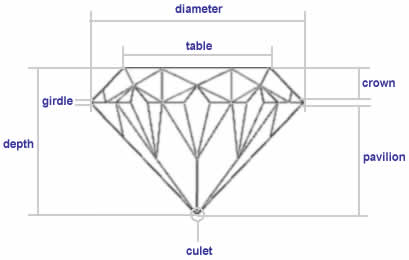
Clarity
Almost all diamonds carry inclusions that cannot be seen by the naked eye. These also make diamonds unique, as no two diamonds are the same. However, these inclusions impact a diamond's clarity. The absence of inclusions or the fewer inclusions a diamond has means better clarity. Therefore, the better the clarity, the greater the value of the diamond.
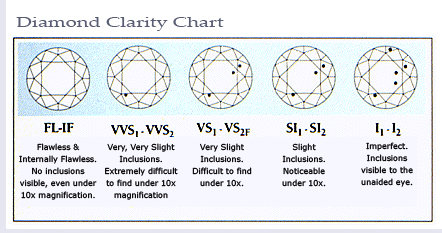
Color
Colorless diamonds come in a variety of color grades that are marked D through Z. D, E and F grade diamonds are the most rare and most expensive. These contain no color. The further down the scale you go, the more yellow appears in the diamond. Once a diamond gets past Z, then it is considered a Fancy color diamond. The more intense the color is of the diamond, the more rare and expensive it will be.

Carat Weight
The weight of a diamond is measured in carats. 1 carat equals 100 points. Diamonds may be referred to as a 3/4 carat stone or a .75 point diamond. The larger the diamond, the more valuable it is, but it should not be the only consideration.
Another factor to consider when buying a diamond is shape. Diamonds come in many shapes, each with unique characteristics. You may favor the flash of a round brilliant or the elegance of an emerald cut. Learn more about the characteristics of each diamond shape below.


ROUND
The round brilliant cut is one of the most popular of the diamond shapes. It is also the most brilliant of all the cuts with a total of 58 facets. Round brilliant diamonds make up a vast majority of diamonds found in engagement rings. To maximize the brilliance of a traditional round diamond, select one in the two highest cut grades: excellent or very good, and choose excellent or very good polish and symmetry grades.

PRINCESS
The face-up shape of the princess cut is square or rectangular and the profile or side shape is that of an inverted pyramid with four beveled sides. This shape can vary greatly in how square or rectangular they are. Its brilliance and unique cut make it a favorite for an engagement ring.

OVAL
The oval cut diamond has beautiful brilliance similar to a round diamond. The modern oval cut is a fiery cut that reflects light brilliantly. It's a great choice for someone who loves the sparkle of a round brilliant, but desires a less common shape.

EMERALD
This shape is cut with rectangular facets which create a unique optical appearance highlighting the clarity of the diamond. The long lines of the emerald cut make it less fiery than a round brilliant, but it also tends to have broader, more dramatic flashes of light.
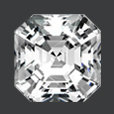
ASSCHER
The Asscher cut diamond was developed in 1902 by the Asscher brothers of Holland. This is a stepped square-cut often called the “square emerald cut”. This beautiful shape is nearly identical to the emerald cut except that it is square.
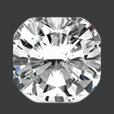
CUSHION
The cushion cut is a square or rectangle cut with rounded corners and 58 brilliant-style facets that resemble a pillow shape. The cushion cut was one of the most popular cuts in the late 19th and early 20th centuries and is making a comeback in popularity.
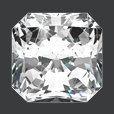
RADIANT
Rectangular in nature, trimmed corners are the signature of this diamond. This cut combines the elegance of the emerald shape with the brilliance of a round with its 62 facets. The radiant can be rectangular or square and looks beautiful set with either baguette or round side diamonds.

PEAR
The pear-shaped diamond is also called the “teardrop diamond” because of its shape. The pear cut is a combination of the round-brilliant and marquise cut. It is a fiery cut with lots of sparkle and flash.
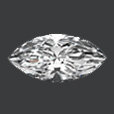
MARQUISE
The standard marquise diamond contains 56 facets. This cut is elongated with pointed ends. It was inspired by the smile of the Marquise de Pompadour and created for France's Louis XIV, who wanted a diamond to match her smile.

HEART
The heart shape diamond is considered to be the most romantic of all the diamond shapes. It is the ultimate symbol of love and makes for a very special and unique engagement ring. Heart shape diamonds contain approximately 59 facets, making it quite fiery with excellent sparkle.
Now that you know about the 4 C's and all about diamond shapes, you are ready to find the perfect diamond! Once you purchase your diamond, make sure to ask your jeweler for a diamond grading report from the GIA. This report verifies the diamond's quality. It is also important to have your diamond appraised by your jeweler and insured in case it is lost or stolen.
We get asked quite frequently how much a person should spend on an engagement ring. There really is no right answer rather it's more about what you feel most comfortable with. The general rule is to spend three months' of your salary on a ring but whether or not you want to use that is completely up to you. At Alson Jewelers, we have rings at all price points. We offer 12 month, interest free financing which can split the cost into equal payments without any interest.
If you're looking to come into the store and walk out with a ring that day, it's entirely possible. If you see one in the case that you like, you can leave that day with it. Moreover, we have hundreds of loose diamonds available on the premises. If you find a setting that you like and a diamond that you like, our master jewelry maker can set the diamond you want in your preferred setting while you wait.
Diamond shopping is an easy and painless experience. Let us help you find the right ring for her!
 Make an Appointment
Make an Appointment 
